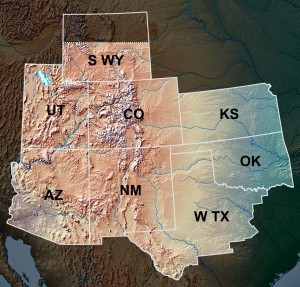The Southwest Partnership
 The Southwest Regional Partnership on Carbon Sequestration (SWP) is one of seven partnerships (RCSP) established in 2003 by the US DOE to study the economic and technical feasibility of capturing and permanently storing carbon dioxide (CO2). Each of the RCSPs has been charged with determining the best geologic and terrestrial carbon management approaches for its specific region and to demonstrate technologies that can best capture, use, or store CO2 . While each Partnership targets its own regional carbon capture, utilization, and storage (CCUS) opportunities, the Partnerships together represent a national initiative. Each partnership has developed a regional carbon management plan to identify the most suitable storage strategies and technologies, aid in regulatory development, and propose appropriate infrastructure for CCUS commercialization within its region. In addition, the Partnerships have contributed significantly to NATCARB, the NETL’s National Carbon Sequestration Database and Geographic Information System, a GIS-based tool developed to provide a view of carbon capture and storage potential. The Partnerships are part of the U.S. DOE’s efforts in carbon management, balancing the needs of energy security and increased concerns over the impact of the increasing concentrations of greenhouse gases—particularly CO2—in the Earth’s atmosphere. The program is managed by the Office of Fossil Energy’s National Energy Technology Laboratory (NETL).
The Southwest Regional Partnership on Carbon Sequestration (SWP) is one of seven partnerships (RCSP) established in 2003 by the US DOE to study the economic and technical feasibility of capturing and permanently storing carbon dioxide (CO2). Each of the RCSPs has been charged with determining the best geologic and terrestrial carbon management approaches for its specific region and to demonstrate technologies that can best capture, use, or store CO2 . While each Partnership targets its own regional carbon capture, utilization, and storage (CCUS) opportunities, the Partnerships together represent a national initiative. Each partnership has developed a regional carbon management plan to identify the most suitable storage strategies and technologies, aid in regulatory development, and propose appropriate infrastructure for CCUS commercialization within its region. In addition, the Partnerships have contributed significantly to NATCARB, the NETL’s National Carbon Sequestration Database and Geographic Information System, a GIS-based tool developed to provide a view of carbon capture and storage potential. The Partnerships are part of the U.S. DOE’s efforts in carbon management, balancing the needs of energy security and increased concerns over the impact of the increasing concentrations of greenhouse gases—particularly CO2—in the Earth’s atmosphere. The program is managed by the Office of Fossil Energy’s National Energy Technology Laboratory (NETL).
SWP uses engineering, geology, chemistry, biology, geographic information systems (GIS), and economics to develop approaches for carbon storage in the Southwest Region. SWP also engages in economic and regulatory analyses, public education and outreach, and regional demonstration projects to deploy and evaluate new technologies.
